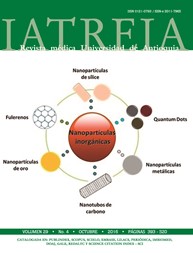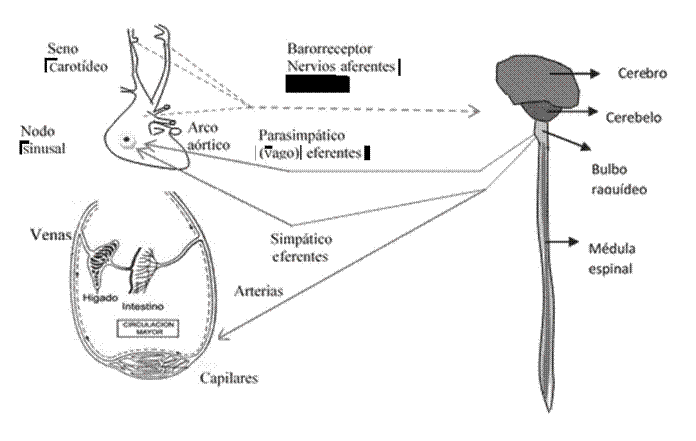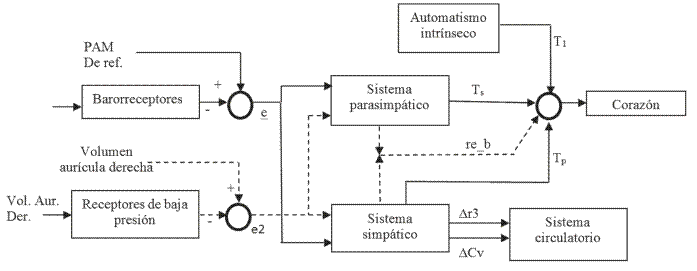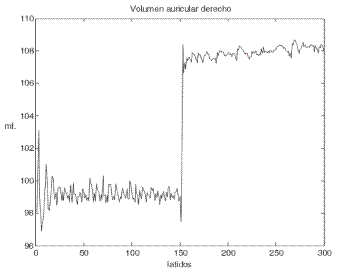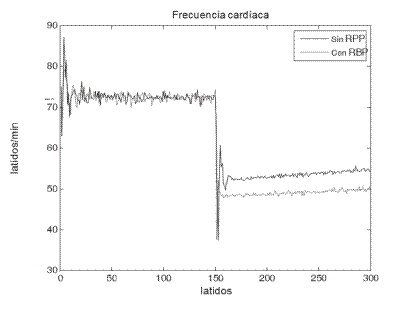Modeling low pressure baroreceptors and their contribution to blood pressure control
DOI:
https://doi.org/10.17533/udea.iatreia.v29n4a03Keywords:
autonomic nervous system, blood pressure, computer simulation, presorreceptorsAbstract
The main mechanism for blood pressure (BP) control is coordinated by the central nervous system through the sympathetic and parasympathetic systems. In order to simulate this mechanism, different mathematical models are available, but they take into account only the high pressure receptors as sensing systems for BP. However, other receptors located in low pressure areas have not, as far as we know, been considered in the models described in the literature, despite their important role in the nervous BP control. This paper presents a mathematical model for the representation of low pressure receptors by means of the detection of atrial volume changes, and their contribution to immediate BP control through nervous stimulation of the heart rate. The proposed model was coupled to the sensor mechanism of a larger model. With this model it is possible to analyze the contribution and behavior of low pressure receptors, thus allowing a better understanding of this complex system under normal and pathological conditions, since it includes important variables in the immediate BP control, not included in previous models.
Downloads
References
(1.) Silverthorn DU. Flujo Sanguíneo y Control de la Presión Arterial. En: Fisiología Humana: Un enfoque integrado. 4a ed. Bogotá: Panamericana; 2008. p. 521-24.
(2.) Guyton AC. Nervous Regulation of the Circulation, and Rapid Control of Arterial Pressure. In: Textbook of Medical Physiology. 11a ed. United States: Elseviers Saunders; 2006. p. 210-15.
(3.) Freire-Maia L, Azevedo AD. The autonomic nervous system is not purely efferent system. Med Hypotheses. 1990 Jun;32(2):91-9. DOI 10.1016/0306-9877(90)90030-I.
(4.) Davila DF, Donis JH, Bellabarba G, Torres A, Casado J, Mazzei de Davila C. Cardiac afferents and neurohormonal activation in congestive heart failure. Med Hypotheses. 2002 Feb;54(2):242-53. DOI 10.1054/mehy.1999.0029.
(5.) Henson MA, Ogunnaike BA, Schwaber JS. Habituating Control Strategies for Process Control. AlChE J. 1995 Mar;41(3):604-18. DOI 10.1002/aic.690410318.
(6.) Vallverdú Ferrer, M. Modelado y simulación del sistema de control cardiovascular en pacientes con lesiones coronarias [tesis doctoral]. Barcelona: Universidad Politécnica de Cataluña, Instituto de Cibernética;
(7.) Ursino M. Interaction between carotid baroregulation and the pulsating heart: a mathematical model. Am J Physiol. 1998 Nov;275(5 Pt 2):H1733-47.
(8.) Djabella K, Medigue C, Sorine M. A Differential Model of the Baroreflex Control of the cardiovascular System During a Tilt Test. In: Proceedings of 44th IEE Conference on Decision and Control, and the European Control Conference; Spain 2005 Dec. Spain: IEEE; 2005. p. 903-8. DOI 10.1109/CDC.2005.1582272.
(9.) de Vet S. People in exercise: A mathematical model of the baroreflex. [cited 2014 Jul 13]. Available from: http://www.mate.tue.nl/mate/pdfs/10872.pdf
(10.) Svetlana P, Jan M, Frantisek M. Human cardiovascular system with heart failure under baroreflex control (numerical model). Acta Bioeng Biomech. 2001;3(1):39-52.
(11.) Danielsen M. Modeling of feedback mechanisms which control the heart function in a view to an implementation in cardiovascular models [PhD Thesis]. Roskilde: Roskilde University, Department of Mathematics
and Physics; 1998.
(12.) Danielsen M, Ottesen JT. A Cardiovascular Model. In: Ottesen JT, Olufsen MS, Larsen JK. Applied Mathematical Models in Human Physiology. Philadelphia: SIAM; 2004. p. 137-200.
(13.) Doyle F, Henson M, Ogunnaike B, Schwaber J, Rybak I. Modeling of the Baroreceptor Reflex with Applications in Process Modeling and Control. In: Omidvar O, Elliot DL, editors. Neural System for Control. New York: Academic Press; 1997. p. 87-122.
(14.) Ramírez J, Moreno F, Rojas R. Modelo de Lazo Cerrado para el Análisis de la Influencia de la Respuesta de los Barorreceptores en la Variabilidad de la Frecuencia Cardiaca. En: Martino L. Desarrollo y avances en métodos numéricos para ingeniería y ciencias aplicadas: memorias del IX Congreso Internacional de Métodos Numéricos en Ingeniería y Ciencias Aplicadas; CIMENICS’ 2008, Isla de Margarita, Venezuela, 31 de marzo al 4 de abril de 2008. Venezuela: Sociedad Venezolana de Métodos Numéricos en Ingeniería; 2008. p. B36-8.
(15.) Sánchez B, Rojas R. Acción nerviosa sobre la resistencia periférica como respuesta al reflejo barorreceptor para el control de la presión arterial. En: XV Congreso Latinoamericano de Control Automático. CLCA 2012 Proceeding; Perú 2012. Lima: Pontificia Universidad Católica del Perú; 2012. p. 124.
(16.) Chandran KB. Rheology of Blood. In: Cardiovascular Biomechanics. New York: New York University Press; 1992. p. 35-93.
(17.) Meste O, Blain G, Bermon S. Some Consideration on the IPFM for the Heart Rate Variability Analysis. [cited 2014 Dec 10]. Available from: http://www.cinc.org/archives/2003/pdf/709.pdf
Published
How to Cite
Issue
Section
License
Copyright (c) 2016 Iatreia

This work is licensed under a Creative Commons Attribution-ShareAlike 4.0 International License.
Papers published in the journal are available for use under the Creative Commons license, specifically Attribution-NonCommercial-ShareAlike 4.0 International.
The papers must be unpublished and sent exclusively to the Journal Iatreia; the author uploading the contribution is required to submit two fully completed formats: article submission and authorship responsibility.


